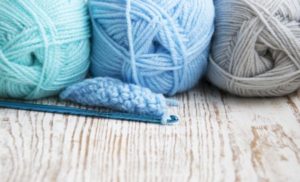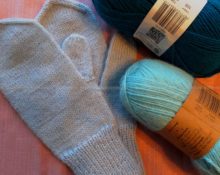With the onset of cold weather, the need invariably arises for mittens that reliably protect your hands from frost.
You can purchase a ready-made version, but many needlewomen prefer to knit such products themselves. In order for the mittens you made yourself to fully meet all expectations, you need to be very careful when choosing suitable threads for knitting.

Which yarn is easier to knit mittens from?
Knitting is not a particularly difficult process, but it requires patience and perseverance. An important role Properly selected threads play a role in obtaining a successful result.

Learn to knit more comfortably with new threads of medium thickness (about 300 m per 100 g). It will be difficult to master loops on threads that are too thin, and even experienced knitters can get tired on threads that are too thick. Mohair – Yarn made from the fluff of Angora goats is very difficult to unravel, it is also recommended to take this into account when choosing such threads. Angora It’s also not very convenient, since short fibers will constantly come out. The best option in this case would be natural wool.

Beginning needlewomen are recommended to try their hand at knitting smooth, plain mittens to begin with. If the result meets your expectations, you can move on to more complex (relief) models.
What yarn mittens will keep you warm even in very cold weather?
Despite all the available variety of yarn varieties, when selecting a suitable material for mittens, it is recommended to consider the following options:
- wool;
- wool mixture;
- acrylic.

Wool seamlessly allows air and moisture to pass through and has high thermal insulation properties. This type of yarn has many advantages: It is natural, flexible and looks great as a finished product.
But in addition to its advantages, it also has negative qualities, for example, a tendency to pilling and stretching. In most cases, sheep (merino), goat (mohair, cashmere), as well as other types of wool are used to make such threads. Wool yarn, which contains synthetic fibers in various proportions, called mixed.

Wool blend is considered to be yarn made of wool containing 10–90% natural fibers (linen, cotton, bamboo) or synthetic threads (acrylic, polyester). This is an excellent material for knitting, which, along with the main advantages of natural wool, also has a number of other advantages provided by the content of other types of fibers. Eg, wool yarn containing acrylic, gains additional lightness. In addition, products made from this material retain their original shape longer.
Acrylic is a fiber of artificial origin, its properties are in many ways similar to natural wool. Acrylic yarn is hypoallergenic, highly durable and resistant to sunlight. This option would be an excellent choice if you need to knit mittens for a baby up to one year old. Main disadvantage These threads are considered to have low hygroscopicity.
Products made from these types of yarn will reliably warm your hands even during severe frosts.
Is yarn composition so important? What should you pay attention to?
The composition, which must be indicated on the tag, is of great importance.
 The quality and appearance of the finished product directly depend on the composition of the yarn from which it was knitted. In addition, when purchasing threads for knitting, it is recommended to pay attention to the following nuances:
The quality and appearance of the finished product directly depend on the composition of the yarn from which it was knitted. In addition, when purchasing threads for knitting, it is recommended to pay attention to the following nuances:
- Thickness and required number of threads. Most instructions for knitting various products indicate the recommended thickness, which is determined by how many meters of thread are contained in 100 g of yarn (or 50 g). The shorter the length of the thread, the thicker it will end up. Typically, one pair of mittens requires 50–100 g of yarn. If you do not yet have experience in this matter, it is recommended to take as a basis the thickness and number of threads that are indicated in the instructions for the selected model.
- Thread uniformity. When choosing skeins, you must inspect them, checking for the presence of knots, compactions and overly thin areas.
- Color. When purchasing skeins of knitting thread that are dyed in different shades and sectional colors, it is recommended to buy those that start with an identical color fragment. It is also necessary to pay attention to avoid any tied or broken thread ends.Their presence can cause difficulties when trying to associate a product with a pattern.
Until the product is completely finished, it is not recommended to throw away the thread tag. If there is not enough yarn, it will be easier to purchase the required quantity, knowing the lot number indicated on the tag.
Experienced knitters recommend that beginners choose melange threads (a mixture of fibers dyed in a variety of shades) for their trial projects. Threads of this kind perfectly mask flaws in the work, and things knitted from them look interesting, even if they were made using the simplest technique.


 0
0





